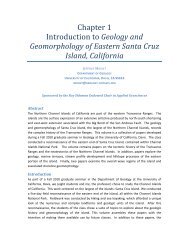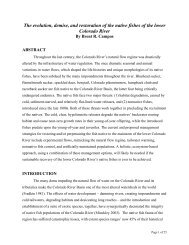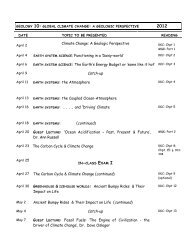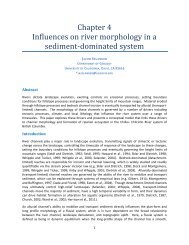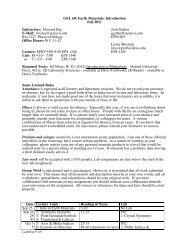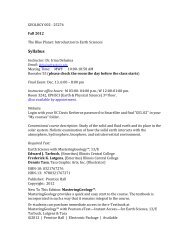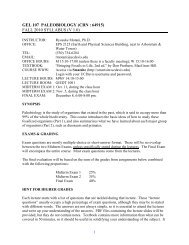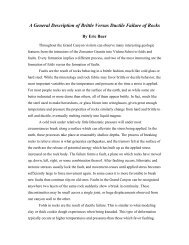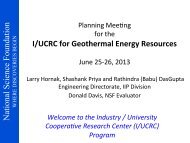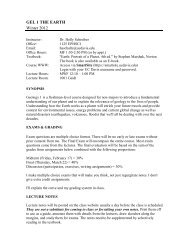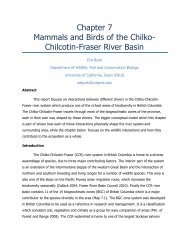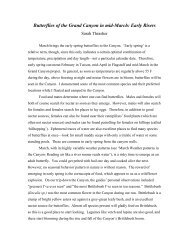Functional Process Zones and the River Continuum Concept
Functional Process Zones and the River Continuum Concept
Functional Process Zones and the River Continuum Concept
You also want an ePaper? Increase the reach of your titles
YUMPU automatically turns print PDFs into web optimized ePapers that Google loves.
E.L. Hestir April 30, 2007<br />
Hydrogeomorphic Patches<br />
Thorp et al. propose an alternative to <strong>the</strong> concept of continuous, longitudinal gradients of<br />
physical conditions. <strong>River</strong>s can instead be viewed as downstream “arrays” or networks (Benda et<br />
al. 2004) of large “hydrogeomorphic patches” formed by catchment-scale geomorphology <strong>and</strong><br />
flow (Thorp et al. 2006). These patches are defined by shifts in hydrological <strong>and</strong> geomorphic<br />
conditions. These physical boundaries (shifts) may be distinct, or indistinguishable by field<br />
observation, but can be delineated using st<strong>and</strong>ard geomorphological techniques <strong>and</strong> terminology<br />
(Thorp et al. 2006). For example, an area of river with a constricted flow channel would be<br />
considered a hydrogeomorphic patch, as would a braided channel, an area with extensive<br />
slackwater, <strong>and</strong> an area with a broad floodplain. These various patches are expected to differ in<br />
physical <strong>and</strong> chemical conditions. Therefore, <strong>the</strong>ir ecological communities should vary<br />
significantly as well. Hence, patterns of ecological structure <strong>and</strong> function in a river network are<br />
controlled by hydrogeomorphic patches. Easily identifiable patches can be used as a template for<br />
<strong>the</strong> identification of “functional process zones,” ecological communities controlled by <strong>the</strong><br />
hydrogeomorphic patches (Thorp et al. 2006).<br />
Hydrogemorphic Patches vs. <strong>Process</strong> Domains<br />
Initially Thorp et al.’s hydrogeomorphic patch concept appears to be synonymous with<br />
Montgomery’s process domains. However, in proposing <strong>the</strong> concept of <strong>the</strong> hydrogeomorphic<br />
patch, Thorp et al. were attempting to distinguish <strong>the</strong>ir patches as similar to, but ultimately more<br />
sophisticated than Montgomery’s process domains. Montgomery’s designation of process<br />
domains takes a “top-down” approach, working from <strong>the</strong> l<strong>and</strong>scape scale disturbance pattern<br />
down to <strong>the</strong> stream. Thorp et al. take a more holistic approach to <strong>the</strong>ir patch designation which is<br />
more in step with Vannote et al.’s original physical variables (width, depth, velocity, <strong>and</strong> flow<br />
volume). Thorp et al. acknowledge that while l<strong>and</strong>scape scale patterns of disturbance are a<br />
significant source of control on patterns of river ecology, hydrologic discontinuities <strong>and</strong> <strong>the</strong><br />
floodplain/riparian zone are also significant physical controls. They intuit <strong>and</strong> acknowledge that<br />
scale matters; <strong>the</strong>se systems are open, <strong>and</strong> fundamentally, patches rely on upstream inputs as<br />
framed by <strong>the</strong> <strong>River</strong> <strong>Continuum</strong> <strong>Concept</strong>. <strong>Process</strong> domains come out of a rejection of <strong>the</strong> RCC,<br />
whereas hydrogeomorphic patches are an attempt to <strong>the</strong> resolve process domains with <strong>the</strong> RCC.<br />
Page 6 of 13



